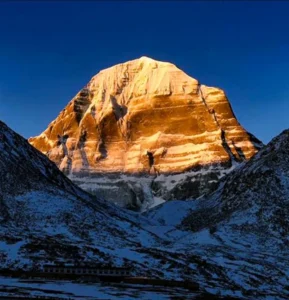GS Paper I – Geography & GS Paper II – International Relations

Context:
The Kailash Mansarovar Yatra is set to resume from June 30, 2025, after a five-year suspension due to the COVID-19 pandemic and Indo-China border tensions. The resumption is being seen as a cultural revival and diplomatic milestone in India–China relations.
GEOGRAPHICAL SIGNIFICANCE
Location:
-
Mount Kailash and Lake Mansarovar lie in the Tibet Autonomous Region of China.
-
Mount Kailash (6,638 m) is part of the Trans-Himalayan range, close to the Karnali and Sutlej river sources.
-
Lake Mansarovar is one of the highest freshwater lakes in the world at an altitude of 4,590 m.
Routes in India:
-
Lipulekh Pass Route (Uttarakhand): Trek-based; geopolitically sensitive due to Nepal’s claims.
-
Nathu La Route (Sikkim): Vehicle-based, more accessible; passes through high-altitude military zones.
Geostrategic Importance:
-
Located near the India–China–Nepal tri-junction.
-
Close to critical Himalayan passes and origins of major rivers (Indus, Brahmaputra, Karnali).
-
High vulnerability to climate change and glacier retreat in the region.
CULTURAL AND RELIGIOUS SIGNIFICANCE
Sacred to Multiple Faiths:
-
Hindus: Abode of Lord Shiva; parikrama around Mount Kailash is considered a path to moksha.
-
Jains: Site where Rishabhdev attained nirvana.
-
Buddhists: Associated with Mount Meru, the cosmic center of the universe.
-
Bon religion: Ancient Tibetan faith also considers it a sacred site.
Pilgrimage Practices:
-
Parikrama (kora): A 52-km circumambulation around the mountain.
-
Holy dip in Mansarovar: Believed to cleanse sins.
-
Limited pilgrimage season (June–September) due to harsh weather and altitude.
INTERNATIONAL RELATIONS DIMENSION
India–China Dynamics:
-
The resumption of the yatra in 2025 signals confidence-building between the two nations post-Galwan.
-
India had suspended the yatra due to China’s border restrictions and COVID protocols.
-
Recently, diplomatic talks led to China reopening the route as a gesture of goodwill.
India–Nepal Sensitivities:
-
Nepal has objected to India’s use of the Lipulekh route, claiming territorial rights.
-
India maintains that the route falls within its sovereign territory.
Soft Power and Cultural Diplomacy:
-
The yatra is a symbol of India’s spiritual diplomacy and strengthens cultural ties with Nepal, Tibet, and China.
-
Acts as a tool for people-to-people contact, even amidst strategic competition.




